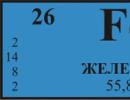Percentage of languages in the world. The most widely spoken languages in the world. The most spoken languages in the world: a list
There are billions of people on our Earth who speak more than 7,000 languages. Consider the most common languages in the world by the number of native speakers.
Chinese
Chinese is spoken by over 1.3 billion people in China, Taiwan and Singapore. It is one of the most difficult languages in the world. But despite this, it is one of the six official languages in the United Nations.
English
English is spoken by about 600 million people in 106 countries. In England, it is the main and official language, and in some countries (India, New Zealand, Canada, etc.) it is one of the official languages along with the other.
Hindi
Hindi is spoken by 490 million people in India, Nepal, Bangladesh and Pakistan.

Spanish
Spanish is spoken by 427 million people in 31 countries. It is the official language in many international organizations: the UN, the EU, etc.
Arab
Arabic used by 267 million people in 58 countries, such as Saudi Arabia, Iraq, Syria and a number of others. The Quran, the main book of Muslims, is written in Arabic. And since 1974, it has also been the sixth official language of the United Nations.
Russian
Russian is used in 17 states and is spoken by 260 million people. It is an official language in the Russian Federation, Kazakhstan, Belarus, Kyrgyzstan and Tajikistan, but is also widely used in other states of the former USSR.
It is the official language of the UN. And if we compare its use in Europe, then it is the most widely used. Among the Slavic languages, Russian is the most widely spoken in the world.

Bengal
Bengali is the official language in Bangladesh and is spoken by 250 million people. It is also used in several states of India.
Portuguese
Portuguese is spoken in 12 countries by 240 million people. In Brazil, it is the official language, as well as in the EU and some other international organizations.
Indonesian
Indonesian is spoken by 200 million people in 16 countries. This is one of the dialects of the Malay language, which was formed in the twentieth century and became widespread. And in East Timor, this language has the status of a working language.

French
The French language is used primarily, of course, in France, as well as in 52 other countries. It is spoken by 150 million people. It is an official language in the EU, the UN, the International Olympic Committee, etc.
Business languages
Above, the most common languages of the world were considered by the number of speakers, but there is also the criterion "the most used language in business communication and correspondence." In our age, when in order to develop a business and make a profit, you need customers and partners around the world, you simply cannot do without knowledge of foreign languages.

If we consider all the languages of the world from this position, then the following will be the most frequently used:
- Of course, English comes first. Almost all business meeting, diplomatic meetings are conducted in this language. It is understood by a third of all inhabitants of the Earth. Even in normal everyday communication, people from different countries speak it to understand each other. Many employers, even when looking for an employee, indicate "knowledge of English" as a mandatory selection criterion. Plus, it's easy enough to learn.
- In second place is Spanish language, which is primarily in demand among Americans who want to better understand the southern population of North America. It is very easy to learn.
- The Chinese language due to the huge number of speakers is considered common. In addition, it has several dialects, the main one being Mandarin. Of great importance when speaking in Chinese is the pitch, because. this is important for understanding the meaning of what has been said. But the grammar is quite simple, which can not be said about writing hieroglyphs, with the correct spelling, which even the Chinese have difficulty.

- Many famous literary masterpieces, materials on science and technology were written in Russian. This is the main language Russian Federation, which is a world power in terms of energy resources and in the economy. For foreigners, it is difficult to learn. It has complex grammar, but logical.
- At present, the Arabic language is very important for negotiations on energy and security. Even when hiring employees, knowledge of this language is of great importance. These workers are well paid. But the Arabic language has many dialects that have significant differences from each other, which limits its use. In addition, it has a very complex grammar and is difficult for a foreigner to write in.
- 50 years ago French was the most sought after. Even more than English. It is easy enough to learn and similar to English.
- In connection with the development of Brazil and the strengthening of its importance in the world market, the Portuguese language is becoming more widespread. It is slightly harder to learn than Spanish, but easier than English and French.

- Since Japan occupies an important place in the world economy, Japanese language is also important and widespread. This is very Difficult language, which has difficult grammar and many grammatical forms that depend on gender and social status speaker.
- The Turkish language was on this list, because. it is easy to learn and Turkey is an important country in the Middle East.
- German is widely spoken in Europe. Business negotiations are often conducted on it. Also, for people who are fond of the history of the twentieth century, knowledge of this language will come in handy. German has a difficult grammar, but the level of difficulty in learning is the same as that of English.
Thus, knowledge of at least one foreign language is important not only for business communication, but also for normal communication when talking with residents of other countries. This will help to better understand their culture, customs and traditions.
The rapidly changing world around, sung by Makarevich, opens its arms wide to both the adventurous traveler and the polyglot in need of communication. For those wishing to successfully combine the two roles, we advise you to put on comfortable sneakers and stock up on greetings from the most common languages of the world, which you will definitely need. The route is set, the visa is received, it remains only to remind yourself of the difference between “trip” and “journey” and hit the road with a light soul!
10. French. 129 million people
First place from the end is occupied by the language of love and romance - French. Going for an iconic photo with the Eiffel Tower in the background, don't forget to smile enigmatically and say "Bonjour" (bonjour) to a random passer-by. It is not a fact, of course, that they will answer you, because the heart of France is oversaturated with tourists from all over the world, speaking any language. But in Belgium, Canada, Rwanda, Cameroon and Haiti, they will appreciate the friendliness shown and say hello in return. In these countries, French is commonly used or even official.
9. Malay-Indonesian. 159 million people
As Captain Obvious would correctly point out, this language is native to the inhabitants of Malaysia and Indonesia. Neighboring states amaze not only with the beauty of nature and the hospitality of the local population, but also with an abundance of dialects, the most popular of which remains Indonesian. Of course, there are fewer dialects than the Indonesian islands (no less than 13,000), but they are all united by both the hot sun and the root language. Through two large regions of Indonesia in Malaysia, the same familiar Malayo-Indonesian language is heard. Arriving in the capital of Malaysia, Kuala Lumpur, greet the Indonesian customs officer “selamat pagi” (selamacht pagi) and go to paradise on the island of Borneo.
8. Portuguese. 191 million people
The inhabitants of little Portugal owe the spread and popularization of Portuguese to their national heroes - the navigators Vasco da Gama and Prince Henry the Navigator. The spirit of adventure and a fair wind brought them and their native language to the other side of the world, namely to Brazil, Angola, Macau, Mozambique and Venezuela. It was a very successful cultural exchange and a contribution to the future of Portuguese, as the population of Brazil, where Portuguese is the official language, is now many times larger than the population of Portugal itself. By the way, the first Portuguese word that sounded on the banks South America, it was "hello" - "bom dia" (bom dia).
7. Bengali. 211 million people
In the birthplace of the sparkler and tiger in Bangladesh, more than 120 million people speak Bengali. It does not take a great mathematician or geographer to ask a reasonable question: how is it that the number of native speakers of a language exceeds the population of its country of origin? Surrounded by overpopulated India, Bangladesh has no objection to the use of Bengali by Hindus. To greet someone in Bengali, just say "Ei Je" (ay jee).
6. Arabic language. 246 million people
Arabic is the language of the countries of the Middle East, where the main religious book of Muslims, the Koran, is held in special honor and respect. Is it worth specifying that it is written in Arabic? Saudi Arabia, Iraq, Kuwait, Syria, Lebanon, Jordan and Egypt have the largest number of Arabic speakers, add to them millions of Muslims around the world and you have a formula for the growth and prosperity of the Arabic language, which became the sixth official language of the UN in 1974. The greeting in Arabic sounds difficult to pronounce: “Al salaam a’alaykum” (al salam aalaykum).
5. Russian language. 277 million people
Russian is spoken not only in Russia, Ukraine, Belarus, Kazakhstan and other post-Soviet countries, but also in any multilingual company in a couple of hours, where two Russian-speaking people communicate. This informal rule has been proven by many years of practice. Foreigners can only accept and learn how to say "hello" in the great and mighty. Russian is one of the six UN languages and is widely spoken around the world, traveling with the many millions of emigrants from Russia.
4. Spanish. 392 million people
The Spanish navigators were even more successful than the Portuguese, rewarding native Spanish natives of Central and South America, Cuba and parts of the United States. By the way, in the modern United States, Spanish is not a weak competitor to English, as if recalling the need to repay debts for previously borrowed "tornado", "bonanza", "patio" and other words. The Spanish language will appeal to all the Olgas and Helgas of the planet Earth, because “hello” in Spanish sounds like “hola” (ola).
3. Hindustani. 497 million people
Yes, yes, this is the official name of the language of multibillion-dollar India, which includes a considerable number of dialects and dialects (the most common of which is Hindi). Indian Bollywood produces many times more Hindi films in a year than all American Hollywood directors dreamed of in 10 years. Brought by the British as a souvenir, their native language also firmly rooted in the Hindustan peninsula, acquiring the status of an auxiliary official, to some extent competing with Hindustani. Greet the good-natured Hindus in their manner by folding your arms at your chest and nodding your head, saying "namaste" (namaste).
2. English. 508 million people
The language spoken around the world, alas, is not gaining enough native speakers to pick up the winner's laurels. Residents of the USA, England, Australia, New Zealand, Canada, South Africa, Hong Kong, Zimbabwe and the Caribbean consider him native. Most likely, you, who are reading this article now, feel some kind of kinship with English. Let's take the opportunity and informally greet each other in our favorite English and enroll our neighbor, mother and cousin in the courses with the hope of leading English in a few years.
1. Mandarin Chinese. Over 1 billion people
It's no secret that "made in China" is much more common than "I love you". The population of China wins this competition due to the population. By the way, English breathes in the back of Chinese in the homeland of the victorious language. Learning Mandarin is not easy at all, each word can be pronounced in four different tones, which, of course, confuses beginners. However, more than a billion people have been able to do it, and you too can do it. Let's start the training with the greeting "ni hao" (ni hao), the second part of which should be pronounced as one syllable, making wave-like manipulations of the voice, lowering it in the middle of a syllable and raising it at the end.
That's the whole list of the most popular languages in the world. From it you can choose the best foreign language for you and start learning.
Probably, many of you are surprised or even upset by the second place taken by the English language in this ranking. Don't be discouraged - lovers of Italian and German are in an even more difficult position. Better direct your energy into a productive channel, learning new words or conquering the heights of grammar. English always has something to surprise you, we have a selection in store that will expand your horizons of knowledge and eyes after reading, we promise!
Historically, in different countries the world speak different languages. Among them are those who have no common roots and whose origin is unique. But there are those that are used most often.
The most widely spoken language in the world is Chinese. Almost two billion and a quarter of people speak it. It is the official language of such countries as:
- Singapore,
- China,
- Malaysia,
- Taiwan.
The leader in actual prevalence is Chinese . As you know, it is perhaps the most ancient in the world. It is the official language of four countries, but it remains the mother tongue of millions of Chinese around the world as well. In many cities there are impressive Chinese diasporas. There are also its numerous dialects, which are used by over a fifth of the population of the entire planet. In the United States, there are regulations that require certain documents to be printed in Chinese. By law, this is done where the number of inhabitants is at least a million. In particular, all documents for the elections are duplicated in Chinese. The hieroglyphics of the country is used in the DPRK and Japan.
2nd place. 
About three hundred twenty-nine million people define their native Spanish language. It is also the official language of the UN. And just recently, he occupied not the third position, but the second. He is one of the descendants of the Indo-European family.
3rd place. 
The third position is English . International communication not as inaccessible as it seems. A prime example is English. Sometimes you need to know it in order to achieve career growth. In each country, English language courses are mastered, since its knowledge is very prestigious. About one and a half billion people have learned this language, it is used for communication in most countries. He has great importance for culture, politics, trade relations. It is recognized as one of the official languages of the UN. It is widely used in the field of computer technology. Spanish is spoken by a million more people.
4th place. 
Arabic - native to twenty-one million people.
5th place. 
6th place. 
At least ten states communicate on Portuguese . That is, one hundred and seventy-eight million people own it.
7th place. 
bengali also often used as a means of communication.
8th place. 
Russian language the most popular among the Slavic. It is the mother tongue of one hundred and forty-four million. It is the official language in Russia, Belarus, Kyrgyzstan, Kazakhstan. It is spoken by residents of several communes in Romania and the US state of New York. The degree of interest in the language and the need to study it determines the territorial coverage, as well as trade relations. Recently, interest in this language has increased. It has become an object of study in many countries, taking one of the ten most common places in the world. It has long been used by the participants of the Parisian forum of linguists, where it has long enjoyed great attention. This is how the “popularity index” of languages is determined.
9th place. 
Japanese language use one hundred and twenty-five million.
10th place. 
On the Mandarin communicates with almost a billion people. It is included in the list of 6 official languages of the UN. This language exists in 1200 million variants. This is the language of communication of the inhabitants of northern and southwestern China. Mandarin is a member of the Sino-Tibetan family. It is difficult to master, it has several dialects, each of which has many tones. Almost every region uses its own version of the language.
Language is perhaps the most important function of the human body - it allows us to get food as a child, it allows us to get almost anything we want as adults, and it also gives us many hours of entertainment through literature. , radio, music, and movies. This list (in order from least common) summarizes the most important languages in use today.
10. French
Number of speakers: 129 million
Often referred to as the most romantic language in the world, French is spoken in many countries including Belgium, Canada, Rwanda, Cameroon and Haiti. Oh yes, and in France too. We're actually very lucky that French is so popular, because without it, we'd be at a dead end with Dutch Toast, Dutch French Fries and Dutch Kissing (ugh!).
To say "hello" in French, say "Bonjour" (bon-JUR).

9. Malay-Indonesian language
Number of speakers: 159 million
Malayo-Indonesian is spoken - surprise - in Malaysia and Indonesia. In fact, we will deviate from the quantity because there are many Malay dialects, the most popular of which is Indonesian. But they are all largely based on the same root language, making it the ninth most spoken language in the world.
Indonesia is a charming place; The nation consists of more than 13,000 islands, it is the sixth most populous country in the world. Malaysia is bordered by two major areas Indonesia (including the island of Borneo), and is mostly known for its capital Kuala Lumpur.
To say “hello” in Indonesian, say “Selamat pagi” (se-la-macht pa-gi).

8. Portuguese
Number of speakers: 191 million
Think of Portuguese as a small language. In the 12th century, Portugal gained independence from Spain and expanded throughout the world with the help of its famous explorers such as Vasco da Gama and Prince Henry the Navigator. (It's good that Henry became a navigator... could you imagine if a guy named "Prince Henry the Navigator" became a florist?) is the national language), Macau, Angola, Venezuela, and Mozambique.
To say "hello" in Portuguese, let's say "Bom dia" (Bom DI-a).

7. Bengali language
Number of speakers: 211 million
In Bangladesh, a country of over 120 million people, Bengali is spoken by just about everyone. And because Bangladesh is actually surrounded by India (where the population is growing so fast that it feels like breathing the air you can get pregnant), the number of Bengali speakers in the world is much higher than most people would expect.
To say "hello" in Bengali, say "Ei Je" (Ai-jay).

6. Arabic language
Number of speakers: 246 million
Arabic, one of the oldest languages in the world, is spoken in the Middle East, with speakers found in countries such as Saudi Arabia, Kuwait, Iraq, Syria, Jordan, Lebanon, and Egypt. Also, because Arabic is the language of the Quran, millions of Muslims in other countries also speak Arabic. So many people have a working knowledge of Arabic, in fact, which made it the sixth official language of the United Nations in 1974.
To say “hello” in Arabic, say “Al salaam a’alaykum” (Al sa-LAM a a-LEY-kum).

5. Russian language
Number of speakers: 277 million
Mikhail Gorbachev, Boris Yeltsin, and Yakov Smirnov are among the millions of Russian speakers. Of course, we used to think of them as our communist enemies. Now we think of them as our communist friends. One of the six languages at the UN, Russian is spoken not only in his homeland, but also in Belarus, Kazakhstan and the USA (we name a few places).
To say "hello" in Russian, say "Hello" (Hello).

4. Spanish
Number of speakers: 392 million
Except for all those children who study it in high school, Spanish is spoken in just about every South American and Central American country, not to mention Spain, Cuba and the United States. There is a particular interest in the Spanish language in the United States, since many English words borrowed from their language, including: tornado, bonanza, patio, quesadilla, enchilada, and taco grande supreme.
To say "hello" in Spanish, say "Hola" (OH-LA).

3. Hindustani
Number of speakers: 497 million
Hindustani is the main language of overpopulated India, and it includes a huge number of dialects (of which Hindi is the most widely spoken). While many predict that India's population will soon outnumber China, the acceptance of English in India prevents Hindustani from being recognized as the world's most spoken language. If you're interested in getting a little Hindi, there's a very easy way: Rent an Indian movie. The film industry in India is the most prosperous in the world, producing thousands of action/romance/musicals every year.
To say "hello" in Hindustani, say "Namaste" (Na-ma-ste).

2. English
Number of speakers: 508 million
While English does not have a majority of speakers, it is the official language more countries than any other language. It is spoken all over the world including New Zealand, USA, Australia, England, Zimbabwe, Caribbean, Hong Kong, South Africa and Canada. We would tell you more about English, but you are probably already quite comfortable in this language. Let us just go on and on about the most popular languages in the world.
Today there are a huge number of language schools offering English courses in Moscow. The courses are taught according to the latest educational methods. You study in English, without using Russian. All new words and concepts are explained by already familiar words, gestures, pictures - this makes the learning process much more interesting and interactive, and if learning is interesting, then the results will be better! All new constructions and words after studying are immediately fixed in practice, when working in pairs and mini groups. Thus, learning English in courses is not limited to getting acquainted with grammar and memorizing new words: you learn exactly how to communicate.

1. Mandarin Chinese
Number of speakers: more than 1 billion
Surprise, surprise, the most widely spoken language on the planet is in the most populated country on the planet. Second-placed English has a 2-to-1 ratio of speakers, but that shouldn't make you think that Chinese is easy to learn. Conversational Mandarin can be very tough because each word can be pronounced in four directions (or “tones”), and beginners are bound to have trouble distinguishing one tone from another. But if over a billion people could do it, you could too. Try to say hi!
To say “hello” in Chinese, say “Ni hao” (Ni Hao). (“Hao” is pronounced as one syllable, but the tone requires your voice to drop halfway and then rise again at the end.)
We are all used to the second foreign language must be English. The entire IT industry, all areas of science, as well as most foreign forums are held in English. At present, knowing English, great opportunities are opening up for a person for his development. We are used to the fact that English is the international language.
But few people know that in addition to English, Arabic, Spanish, Chinese, Russian and French are also international languages - these languages are official languages UN.
But what is the most widely spoken language in the world? This question was answered by "Ethnologue" - the most famous guide to the world's languages, published annually since 1951. According to the results of research by specialists from Ethnologue and the supplement released in 2016, the site has prepared the twenty most common languages in the world.
1. First place Chinese. This language is spoken by 1.284 billion people. The language is used by 37 countries of the world, the main country is of course China.
2. In second place, as it is not surprising, Spanish. Thanks to the active colonial activity of Spain in the Middle Ages, Spanish is the official language in almost all countries of South and Central America. Spanish is the mother tongue of 437 million people in 31 countries.

3. English language takes only third place. 372 million people speak this language in 106 countries of the world.

4. Arabic occupies the fourth position. 295 million people speak this language in 57 countries around the world. The largest countries are Saudi Arabia, Algeria, Egypt, Syria.

5. Top five Hindi, from India. Despite the fact that almost 1.3 billion people live in India, there are 447 different languages spoken there, 2 thousand dialects. The most common of them is Hindi, which is spoken by only 260 million people.
 Hindi.
Hindi. 6. bengali, 242 million people in 4 countries, the main carrier state is Bangladesh.
7. Portuguese, 219 million people in 13 countries, the main carrier state is Portugal.
8. Russian, 154 million people in 19 countries, the main carrier state is Russia.
9. Japanese, 128 million people in 2 countries, the main carrier state is Japan.
10. Punjabi(languages of the Indian West Punjab and adjacent areas of Pakistan), 119 million people in 6 countries, the main carrier state is Pakistan.
11. Javanese, 84.4 million people in 3 countries, the main carrier state is Indonesia.
12. Korean, 77.2 million people in 7 countries, the main carrier state is South Korea.
13. Deutsch, 76.8 million people in 27 countries, the main carrier state is Germany.
14. French, 76.1 million people in 53 countries, the main carrier state is France.
15. Telugu, 74.2 million people in 2 countries, the main carrier state is India.
16. Marathi, 71.8 million people, distributed mainly in India.
17. Turkish, 71.1 million people in 8 countries, the main carrier state is Turkey.
18. Urdu, 69.1 million people in 6 countries, the main carrier state is Pakistan.
19. Vietnamese, 68.1 million people in 3 countries, the main carrier state is Vietnam.
20. Tamil, 68.0 million people in 7 countries, the main carrier state is India.
Thus, in order for every third inhabitant of the earth to understand you, it is enough to know Chinese, Spanish and English languages. Despite everything, English still occupies a leading position among highly developed countries, but Chinese is already "sneaking on the heels."






